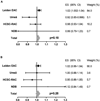Association of valine and leucine at HLA-DRB1 position 11 with radiographic progression in rheumatoid arthritis, independent of the shared epitope alleles but not independent of anti-citrullinated protein antibodies
- PMID: 25580908
- PMCID: PMC4417503
- DOI: 10.1002/art.39018
Association of valine and leucine at HLA-DRB1 position 11 with radiographic progression in rheumatoid arthritis, independent of the shared epitope alleles but not independent of anti-citrullinated protein antibodies
Abstract
Objective: For decades it has been known that the HLA-DRB1 shared epitope (SE) alleles are associated with an increased risk of development and progression of rheumatoid arthritis (RA). Recently, the following variations in the peptide-binding grooves of HLA molecules that predispose to RA development have been identified: Val and Leu at HLA-DRB1 position 11, Asp at HLA-B position 9, and Phe at HLA-DPB1 position 9. This study was undertaken to investigate whether these variants are also associated with radiographic progression in RA, independent of SE and anti-citrullinated protein antibody (ACPA) status.
Methods: A total of 4,911 radiograph sets from 1,878 RA patients included in the Leiden Early Arthritis Clinic (The Netherlands), Umeå (Sweden), Hospital Clinico San Carlos-Rheumatoid Arthritis (Spain), and National Data Bank for Rheumatic Diseases (US) cohorts were studied. HLA was imputed using single-nucleotide polymorphism data from an Immunochip, and the amino acids listed above were tested in relation to radiographic progression per cohort using an additive model. Results from the 4 cohorts were combined in inverse-variance weighted meta-analyses using a fixed-effects model. Analyses were conditioned on SE and ACPA status.
Results: Val and Leu at HLA-DRB1 position 11 were associated with more radiographic progression (meta-analysis P = 5.11 × 10(-7)); this effect was independent of SE status (meta-analysis P = 0.022) but not independent of ACPA status. Phe at HLA-DPB1 position 9 was associated with more severe radiographic progression (meta-analysis P = 0.024), though not independent of SE status. Asp at HLA-B position 9 was not associated with radiographic progression.
Conclusion: Val and Leu at HLA-DRB1 position 11 conferred a risk of a higher rate of radiographic progression independent of SE status but not independent of ACPA status. These findings support the relevance of these amino acids at position 11.
Copyright © 2015 by the American College of Rheumatology.
Figures






Similar articles
-
Brief Report: Main Contribution of DRB1*04:05 Among the Shared Epitope Alleles and Involvement of DRB1 Amino Acid Position 57 in Association With Joint Destruction in Anti-Citrullinated Protein Antibody-Positive Rheumatoid Arthritis.Arthritis Rheumatol. 2015 Jul;67(7):1744-50. doi: 10.1002/art.39105. Arthritis Rheumatol. 2015. PMID: 25777156
-
Characterization of cumulative joint damage patterns in patients with rheumatoid arthritis: a clinical, serological, and gene polymorphism perspective.J Rheumatol. 2015 Mar;42(3):405-12. doi: 10.3899/jrheum.131177. Epub 2015 Feb 1. J Rheumatol. 2015. PMID: 25641888
-
Association between HLA class II genes and autoantibodies to cyclic citrullinated peptides (CCPs) influences the severity of rheumatoid arthritis.Arthritis Rheum. 2004 Jul;50(7):2113-21. doi: 10.1002/art.20316. Arthritis Rheum. 2004. PMID: 15248208
-
How RA Associated HLA-DR Molecules Contribute to the Development of Antibodies to Citrullinated Proteins: The Hapten Carrier Model.Front Immunol. 2022 Jun 10;13:930112. doi: 10.3389/fimmu.2022.930112. eCollection 2022. Front Immunol. 2022. PMID: 35774784 Free PMC article. Review.
-
Determining in which pre-arthritis stage HLA-shared epitope alleles and smoking exert their effect on the development of rheumatoid arthritis.Ann Rheum Dis. 2022 Jan;81(1):48-55. doi: 10.1136/annrheumdis-2021-220546. Epub 2021 Jul 20. Ann Rheum Dis. 2022. PMID: 34285049 Free PMC article. Review.
Cited by
-
Current Understanding of an Emerging Role of HLA-DRB1 Gene in Rheumatoid Arthritis-From Research to Clinical Practice.Cells. 2020 May 2;9(5):1127. doi: 10.3390/cells9051127. Cells. 2020. PMID: 32370106 Free PMC article. Review.
-
Impact of the HLA-DRB1 shared epitope on responses to treatment with tofacitinib or abatacept in patients with rheumatoid arthritis.Arthritis Res Ther. 2021 Aug 31;23(1):228. doi: 10.1186/s13075-021-02612-w. Arthritis Res Ther. 2021. PMID: 34465391 Free PMC article.
-
Genetics of rheumatoid arthritis susceptibility, severity, and treatment response.Semin Immunopathol. 2017 Jun;39(4):395-408. doi: 10.1007/s00281-017-0630-4. Epub 2017 May 29. Semin Immunopathol. 2017. PMID: 28555384 Free PMC article. Review.
-
Aberrant Activation of Immune and Non-Immune Cells Contributes to Joint Inflammation and Bone Degradation in Rheumatoid Arthritis.Int J Mol Sci. 2023 Nov 1;24(21):15883. doi: 10.3390/ijms242115883. Int J Mol Sci. 2023. PMID: 37958864 Free PMC article. Review.
-
The complex genetics of gait speed: genome-wide meta-analysis approach.Aging (Albany NY). 2017 Jan 10;9(1):209-246. doi: 10.18632/aging.101151. Aging (Albany NY). 2017. PMID: 28077804 Free PMC article.
References
-
- De Rooy DP, Zhernakova A, Tsonaka R, Willemze A, Kurreeman BA, Trynka G, et al. A genetic variant in the region of MMP-9 is associated with serum levels and progression of joint damage in rheumatoid arthritis. Ann Rheum Dis. 2014;73:1163–1169. - PubMed
-
- Van der Helm-van Mil AH, Huizinga TW, Schreuder GM, Breedveld FC, de Vries RR, Toes RE. An independent role of protective HLA class II alleles in rheumatoid arthritis severity and susceptibility. Arthritis Rheum. 2005;52:2637–2644. - PubMed
-
- Van der Woude D, Lie BA, Lundstrom E, Balsa A, Feitsma AL, Houwing-Duistermaat JJ, et al. Protection against anti–citrullinated protein antibody–positive rheumatoid arthritis is predominantly associated with HLA–DRB1*1301: a meta-analysis of HLA–DRB1 associations with anti–citrullinated protein antibody–positive and anti–citrullinated protein antibody–negative rheumatoid arthritis in four European populations. Arthritis Rheum. 2010;62:1236–1245. - PubMed
Publication types
MeSH terms
Substances
Grants and funding
LinkOut - more resources
Full Text Sources
Other Literature Sources
Medical
Research Materials

